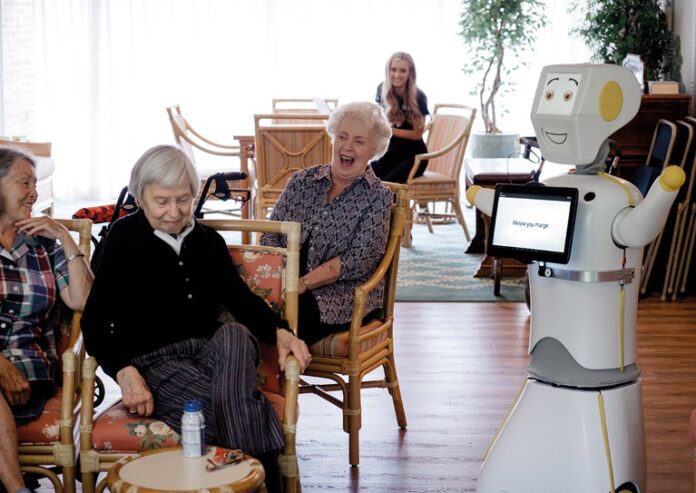Assistive robots have not quite reached the level of The Jetsons, the animated 1960s sitcom in which Rosie the robot maid zipped around a futuristic house doing all the chores people would rather avoid. But in a few years, robotic assistants might routinely feature in older people’s homes, helping them to care for themselves, providing emotional support, and allowing remote access for doctors and nurses. In retirement homes, they could entertain residents or help with cleaning. And in hospitals, they are already taking over some basic tasks, freeing up nurses to focus on patient care.
To work out how robots might be used in retirement homes, McGinn and his colleagues built Stevie, a white robot on a rolling base with short, moveable arms and a head that displays cartoon eyes and a mouth. In 2018 and 2019, they tested Stevie at the Knollwood Military Retirement Community in Washington DC, a facility with 300 older residents. The idea, McGinn says, was not to swoop in with a ready-made piece of technology, but to learn from staff and residents how a robot could improve their experiences.
All-singing all-cleaning
The robot took over some entertainment activities, calling bingo and leading a sing-along, freeing up staff to attend to residents’ individual needs. “Stevie could be the novelty at the front of the room,” McGinn says. But it can also do other things many caregivers cannot, such as speak in different languages and display subtitles when it talks. “Stevie could do all these things that are normally outside of that core expertise or knowledge that you’d expect caregivers to have,” McGinn adds.
The robot needs to be versatile enough to help out around the facility. It might patrol corridors at night to make sure a resident hasn’t gone wandering, or it could perform cleaning duties. “It’s a force multiplier for care staff,” McGinn says. “It’s not to replace people, but it’s to augment how people care for people.”
As people age, their peer groups shrink and they tend to become less mobile, which can lead to boredom and depression, Matarić says. Social robots can help stave off some of those feelings.
“This is not a replacement for human care, but to slightly diminish the care gap that people are experiencing — the extreme loneliness and isolation,” she says. “It’s always better if you can have a caring human.”
Sensors like this are currently available at every intensive-care bed, but in less-urgent care settings and assisted-living facilities, caregivers typically need to hunt for the appropriate equipment, says Nacim Ramdani, a control systems engineer and head of the robotics department at the University of Orleans, France. “Periodic monitoring could be done more cheaply, because you do not necessarily need the nurse running around,” he says.
Personal care
Robots that conduct simple tasks or provide social and cognitive support are clearly important, but Charles Kemp is focusing on robots that can help people feed, clean or dress themselves and perform household tasks, an area that Li is also hoping to address.
Dressing is one of five ‘activities of daily life’ that roboticists are trying to get machines to help with. Dressing, feeding and washing are areas where Kemp thinks good progress is being made. The other two — helping people use the toilet and moving them from place to place, perhaps from a chair into a bed — are more difficult tasks that he has yet to tackle.
The main challenge he sees lies in teaching robots how to act around people. “If you want robots to play a more active role and to be more autonomous, how can you give them the common sense to not do something really dumb?” he asks. “If we really want to reach the full potential of robotic caregivers, they have a lot to learn.”
Analysis
Having a robot AI to assist older individuals in a nursing home, hospital, or even at home is something that I believe can benefit a lot of people. Not only family members, caretakers, etc., but also professional that work in hospitals and nursing homes too. With the rise of older individuals, the demands for workers can equal the amount of care needed for people, which in turn, can make it very expensive for someone to provide proper housing and care for someone they are unable to watch all day long. I feel this technology, with much more development and research, can help older individuals feel more independent but also able to keep an eye out for them to possible live a more private life if they chose to do so.




